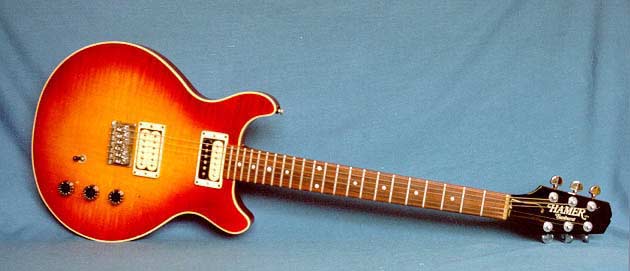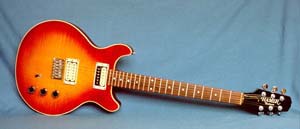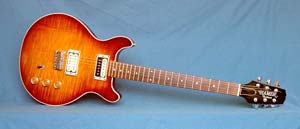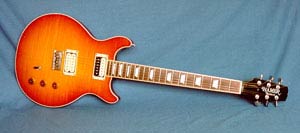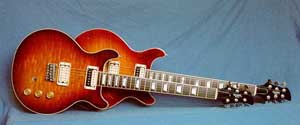by Andrew Large
The Origin of the Sunburst Guitar
The first production model produced by Hamer (in 1975) was the explorer-shaped Standard (originally called just the Hamer Guitar). This was an expensive hand-made instrument made of mahogany with a bound flame maple top which was made in limited numbers. By 1977 Hamer wished to incorporate many of the features of the Standard in a more affordable guitar that was within the reach of the ordinary musician and not just for professionals. Therefore the double cut-away Sunburst was conceived. Jol Dantzig estimates that until the introduction of the Sunburst, Hamer had only made about seventy-five guitars in total, about fifty of these being Standards.
The Sunburst was constructed in the same way as the Standard with a single-piece mahogany neck with a rosewood fingerboard. The single-piece mahogany body had a bound curly maple overlay although the top was a single piece of maple and not book-matched in the same way as Standard. The stop-tail piece and tune-o-matic bridge were dispensed with in favour of an almost Fender style fixed bridge raised up on a wooden shim which allowed through body stringing. Originally the guitar was to be available only in cherry sunburst finish with the choice of a bound neck with crown inlays or unbound with dot inlays. Two different calibrated (to Hamer specs.) DiMarzio PAF pickups were fitted – a creme bridge and a zebra neck. A three-way pickup selector switch, two separate volumes and a master tone completed the electronics.
The first four prototype Sunbursts were built in time to be shown at the June 1977 NAMM Show and carried no serial number. One of them can be seen in Rick Nielson’s book “Guitars of the Stars”. The first “production” Sunburst (7 0001) has recently been on show at the Smithsonian (see the link to Jol Dantzig’s Page). The Sunbursts had a numbering system that was separate from Standards and custom-order instruments and was inked rather than stamped on the rear of the headstock. The first digit represents the year of manufacture and the second four digits are the total number of guitars produced. The introduction of a “production” Hamer to be made in relatively large quantities meant their relocation to a larger workshop in Palatine, Illinois.
The Evolution of the Sunburst
The Sunburst guitar was refined following its introduction and a number of details changed. A 1977 or early 1978 Sunburst is different in many respects to the later guitars. There were also many custom versions of the Sunburst.
|
The earliest Sunbursts such as the 1978 example shown above have a bridge raised on a rosewood or ebony shim. The spacing of the strings is wider with this style of bridge so the string ferules at the back of the guitar are further apart than on later guitars. The photo. below shows an early bridge and wooden-shim. |
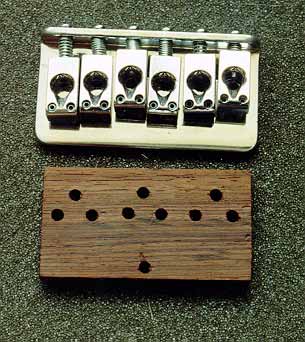 Left, an early bridge and rosewood shim. |
|
The neck was carved from a single piece of mahogany with a long and elegant angled-back headstock with a pronounced “lip” or “open-book” shape at the top. Grover “kidney-button” tuners were usually fitted and on the earliest guitars these have bull’s-eye backs rather than a smooth back cover. By the end of 1978 the Sunburst was beginning to evolve. The wooden shim and bridge were replaced by a purpose built bridge milled out of solid brass and chrome plated although the same pattern saddles continued to be used. The long style of headstock was modified to have a shorter distance between the nut and the first tuner giving a more squat appearance. The phenolic back-plate found on the earliest Sunbursts was replaced by a stamped aluminium backplate. The pickups were wired out-of-phase electrically an all but the earliest Sunbursts, as the early DiMarzio PAFs had a single conductor wire and shielding (which was used as the ground conductor). The photo. below shows the difference between an ea |
 Note that the left headstock (1978) is longer and has a more pronounced “lip” shape at the top compared to the 1982 example on the right. Also note that Schaller machine heads have replaced the kidney-button Grovers. |
|
During 1979 the single-piece neck was replaced by a three piece mahogany neck to provide more stability although on guitars with an opaque finish no change would be noticable. The Grovers also tend to be the smooth back style on intruments made later in 1979. The name of Sunburst had become somewhat illogical as the model was being produced in a variety of transparent and opaque finishes. |
|
By the beginning of 1980 some 1500 Sunbursts had been built. 1980 was a significant year for Hamer. A new model called the Special had been introduced at the end of 1979. This was basically a “dot” Sunburst without the body binding and these guitars were numbered by the same system as the Sunbursts. It is hard to estimate numbers but fewer Sunbursts were built in 1980 compared to 1979 as the Special was being produced in increasing numbers. This year saw a change to Schaller machinehaeds and the headstock “lip” top became slighly less pronounced (see the above photo. of headstocks). The two octave markers on “dot” necks were also moved closer together at the beginning of this year. Guitars from 1980 also have a quirk not seen on guitars from any other period in that the fingerboard side dots are extremely close together, although I have no explanation for this. 1980 also saw Hamer move to a new location at Arlington Heights where thay would stay until 1997. |
| 1981 saw Hamer’s production at Arlington Heights increase to well over 2000 guitars a year. The Sunburst however would not account for this increase as in addition to the Special, the Prototype and vee-shaped Vector guitars were now in production – the Hamer range was beginning a rapid expansion. Two small modifications were made to the Sunburst (and Special) – firstly the lower cutaway was enlarged by just a few millimeters to improve top-fret access and a new style of saddle was introduced which gave a narrower string spacing; a few guitars from the beginning of 1981 have these smaller saddles on a bridge designed for the wider style . Below shows the 1980 and 1981 style of bridge. Also the 500K potentiometers used by this time were stamped Hamer rather than DiMarzio
|
 Shown left, the narrower string spacing bridge found on guitars 1981 onwards and, right, the earlier style. |
|
|
| 1982 again saw more new Hamer models – the Blitz guitar and bass, the CruiseBass and the Phantom. All these models were numbered along with the Sunbursts whilst the Standard, Eight- and Twelve-string basses and other custom instruments kept a separate system. Numbers are hard to estimate but as the range of Hamer models increased, the number of Sunbursts made must have dropped. Fashion was changing and the Sunburst with its ultra-traditional design was no longer in favour. 1983 and 1984 saw Hamer aim successfully for the rising Heavy Rock market with wild finishes, locking trems. and angular body shapes – although a few must still have been built it looked like the Sunburst story was over.
|
|
The end of the eighties saw a return to more traditional instruments – Paul Reed Smith guitars and the Gibson Les Paul had become fashionable. Hamer, by now part of Kaman Music, responded to this by reissuing the flat-top Sunburst. Minor alterations were made such as bookmatching the maple top, having an optional Floyd-Rose (with a maple neck), Seymour Duncans rather than DiMarzios and replacing the old script Sunburst logo with simpler block lettering. This reissue was short-lived and the old flat-top Sunburst was soon superceeded by the new Sunburst Archtop guitars – but that’s another story! |
| The Sunburst is a classic guitar – traditional construction using top grade materials, excellent craftsmanship, a simple yet versatile design and they have a great tone as well. The original Sunbursts are destined to become highly collectable guitars.
|
Unusual and Custom SunburstsMany star guitarists used the Sunburst including Rick Nielson, Martin Barre, Ian Anderson, Andy Summers and Dave Edmunds. Some of these instruments were customised by Hamer such as the green with yellow lining Sunburst built for Ian Anderson (Click for more details on this guitar). Rick Nielson had many custom Hamers built including some unusual Sunbursts. A “flag” Sunburst was built which had interchangable plastic flags to attach to the front. For the Cheap Trick Japanese tour of 1980 a set of Japanese flag Sunbursts was built and most of these were thrown into the audiences during the tour. The Flag guitar and the remaining Japanese flag Sunburst can be seen in Rick Nielson’s book. Some experimental designs also appeared such as the pair shown below. |
Description from the 1981 and 1982 catalogues
The handbuilt Sunburst series guitar is available in two styles, “dot” and “crown”. The body is Honduras mahogany, accented by one-piece curly maple overlay trimmed with ivoroid binding*. The neck is carved from the choice mahogany and stressed in three directions for maximum stability. The carbon- steel truss rod is fully adjustable allowing corrections for both warp and bow. The fingerboard is constructed of highly figured furniture quality rosewood and both “dot” and “crown” are cut from genuine mother of pearl. Twenty-two wide oval frets are used on a 24.75 inch scale. The unique solid brass bridge/sustain block combination offers individual string height and intonation adjustment . Electronics are exactly the same as the Hamer Standard. The control cavity is sandwiched by two shielding plates to filter out interference. Tuners are by Schaller. Output is via a studio quality jack anchored directly to the guitar body. The Sunburst series is finished in natural lacquers. Colors available are cherry sunburst, transparent cherry, blue, yellow and green. Black is also available.
* Some Sunbursts do have creme binding without any grain but the majoity have grained ivoroid.
Description from the 1990 catalogue
Designed as a “modern vintage” instrument a decade ago, increasing demand has spawned the reissue of this working musician’s axe. The classic look, feel and sweet sustain of the Sunburst model is avilable, correct in every important construction detail. In addition to the original Sustain Block Bridge, the Sunburst is now avilable with Hamer’s modern locking tremolo. When the tremolo version is ordered, the mahogany neck is replaced by maple for added strength. The one-piece mahogany body is visually enhanced with a figured maple overlay and bound with grained ivoroid. Two specially calibrated Seymour Duncan humbuckers are fitted each with its own volume control. Additional controls include a three way toggle switch for pickup selection and a master tone contour. The non-tremolo version employs Hamer’s famous Lubritrak nut, formed of a material whose lubricity exceeds that of graphite. The Sunburst is also available in either Standard or Custom configuration. The Custom features a bound rosewood
* Surprisingly this catalogue is wrong, the Sunburst was introduced mid-1977.
Bibliography
Hamer Tone – vol. 1, no.3.
Vintage Guitar Magazine – Hamer Guitars – A Conversatrion with Jol Dantzig by Dean Farley parts 1 and 2(Sept. 1996 (vol.9 no.12) and Oct. 1996 (vol.10 no.1))
Hamer catalogues from 1975 to 1990.
Guitars of the Stars Vol.1 – Rick Nielson by Bill Rich and Rick Nielson (1993)
Recent Relics – Early Hamer Guitars, parts I (Standard) and II (Sunburst) by Baker Rorick (1997).
